三年级英语句型与语法归纳
三年级英语语法归纳
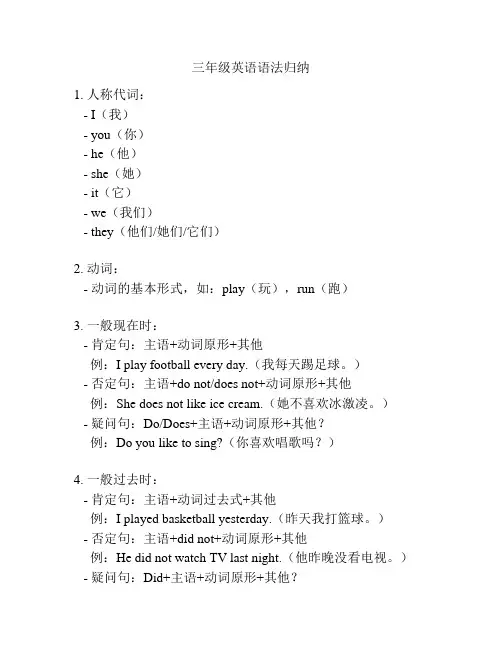
三年级英语语法归纳1. 人称代词:- I(我)- you(你)- he(他)- she(她)- it(它)- we(我们)- they(他们/她们/它们)2. 动词:- 动词的基本形式,如:play(玩),run(跑)3. 一般现在时:- 肯定句:主语+动词原形+其他例:I play football every day.(我每天踢足球。
)- 否定句:主语+do not/does not+动词原形+其他例:She does not like ice cream.(她不喜欢冰激凌。
)- 疑问句:Do/Does+主语+动词原形+其他?例:Do you like to sing?(你喜欢唱歌吗?)4. 一般过去时:- 肯定句:主语+动词过去式+其他例:I played basketball yesterday.(昨天我打篮球。
)- 否定句:主语+did not+动词原形+其他例:He did not watch TV last night.(他昨晚没看电视。
) - 疑问句:Did+主语+动词原形+其他?例:Did they go to the park?(他们去公园了吗?)5. 形容词:- 描述名词的特征或状态- 通常放在名词前面例:a big house(一个大房子)6. 副词:- 描述动词、形容词、副词等- 表示时间、地点、方式、程度等例:He runs quickly.(他跑得快。
)7. 介词:- 表示方向、位置、时间等关系- 如:in(在……里),on(在……上),at(在……处)8. 句子的基本结构:- 主语+谓语+宾语/补语- 例:I like apples.(我喜欢苹果。
)以上是三年级英语的基本语法归纳,希望对您有帮助!。
小学三年级英语常用重点句型+语法知识总结
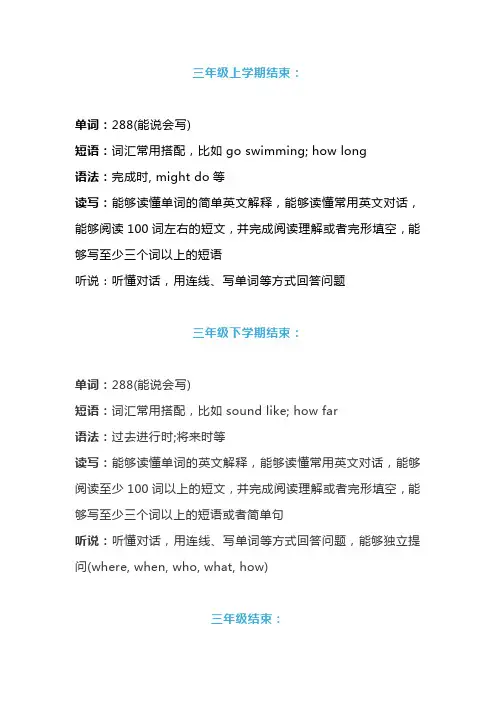
三年级上学期结束:单词:288(能说会写)短语:词汇常用搭配,比如go swimming; how long语法:完成时, might do等读写:能够读懂单词的简单英文解释,能够读懂常用英文对话,能够阅读100词左右的短文,并完成阅读理解或者完形填空,能够写至少三个词以上的短语听说:听懂对话,用连线、写单词等方式回答问题三年级下学期结束:单词:288(能说会写)短语:词汇常用搭配,比如sound like; how far语法:过去进行时;将来时等读写:能够读懂单词的英文解释,能够读懂常用英文对话,能够阅读至少100词以上的短文,并完成阅读理解或者完形填空,能够写至少三个词以上的短语或者简单句听说:听懂对话,用连线、写单词等方式回答问题,能够独立提问(where, when, who, what, how)三年级结束:背诵能力:轻松背诵100词以上短文或者对话读写:能够阅读100词以上文章,并书写3个单词词以上的英文答案听说:能够听懂简单的常用英文对话,能够使用where等疑问词独立提问小学三年级英语重点句型1. Hello!喂 Hi! 嗨2. Hello! I'm Wu Yifan. I'm from China.你好!我叫吴一凡。
我来自中国。
3. What's your name?你叫什么名字?4. My name's Chen Jie. 我的名字叫陈洁5. I have a pencil. 我有一只钢笔。
Me too.我也是。
6. Good morning.早上好Good afternoon.晚上好7. This is Miss White. 这是Miss White。
Nice to meet you. 很高兴认识你。
8. Where are you from?你来自哪里?I'm from America. 我来自美国。
9. Let's go to school.让我们一起去学校。
三年级英语句型与语法归纳
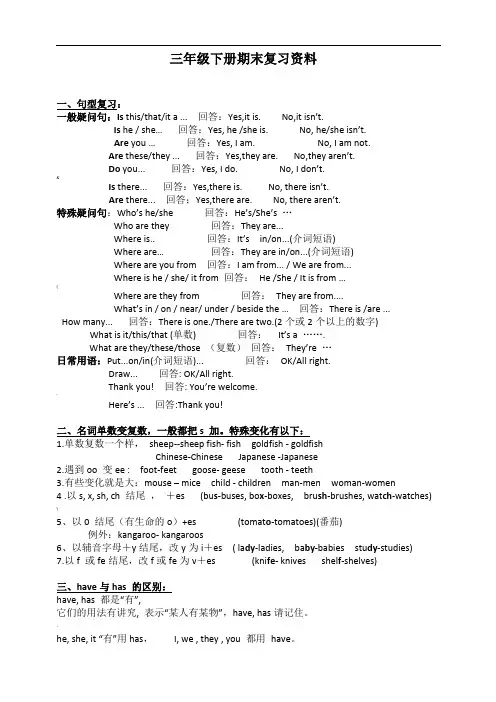
三年级下册期末复习资料一、句型复习:一般疑问句:Is this/that/it a ... 回答:Yes,it is. No,it isn’t.Is he / she…回答:Yes, he /she is. No, he/she isn’t.Are you …回答:Yes, I am. No, I am not.Are these/they ... 回答:Yes,they are. No,they aren’t.Do you... 回答:Yes, I do. No, I don’t.&Is there... 回答:Yes,there is. No, there isn’t.Are there... 回答:Yes,there are. No, there aren’t.特殊疑问句:Who’s he/she 回答:He’s/She’s…Who are they 回答:They are...Where is.. 回答:It’s in/on...(介词短语)Where are…回答:They are in/on...(介词短语)Where are you from 回答:I am from... / We are from...Where is he / she/ it from 回答:He /She / It is from …(Where are they from 回答:They are from....What’s in / on / near/ under / beside the …回答:There is /are ...How many... 回答:There is one./There are two.(2个或2个以上的数字) What is it/this/that (单数) 回答:It’s a …….What are they/these/those (复数)回答:They’re …日常用语:Put...on/in(介词短语)... 回答:OK/All right.Draw... 回答: OK/All right.Thank you! 回答: You’re welcome.'Here’s ... 回答:Thank you!二、名词单数变复数,一般都把s 加。
小学英语三年级上册语法
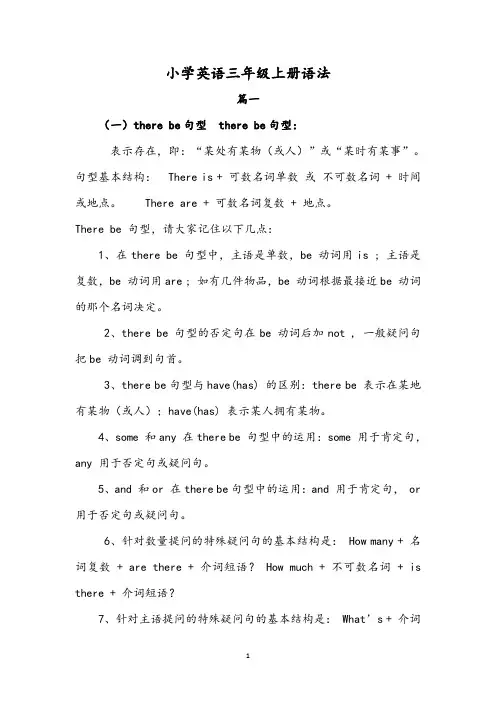
小学英语三年级上册语法篇一(一)there be句型 there be句型:表示存在,即:“某处有某物(或人)”或“某时有某事”。
句型基本结构:There is + 可数名词单数或不可数名词 + 时间或地点。
There are + 可数名词复数 + 地点。
There be 句型,请大家记住以下几点:1、在there be 句型中,主语是单数,be 动词用is ; 主语是复数,be 动词用are ; 如有几件物品,be 动词根据最接近be 动词的那个名词决定。
2、there be 句型的否定句在be 动词后加not , 一般疑问句把be 动词调到句首。
3、there be句型与have(has) 的区别:there be 表示在某地有某物(或人);have(has) 表示某人拥有某物。
4、some 和any 在there be 句型中的运用:some 用于肯定句,any 用于否定句或疑问句。
5、and 和or 在there be句型中的运用:and 用于肯定句, or 用于否定句或疑问句。
6、针对数量提问的特殊疑问句的基本结构是: How many + 名词复数 + are there + 介词短语? How much + 不可数名词 + is there + 介词短语?7、针对主语提问的特殊疑问句的基本结构是: What’s + 介词短语? ------------------------------------------------------------------------考考你: 1、____ a story-book on the table. A. There are B. There have C.There is 2、____ any books in the bookcase A. Are thereB. Is thereC. What is3、How many students____in the classroom? A. are B. are there C. is there C. is there小学英语三年级上册语法篇二人称代词是表示“我”、“你”、“他”、“她”、"它"、"我们"、"你们"、"他们"的词,是表示自身或人称的代词。
三年级下册英语句型与语法归纳
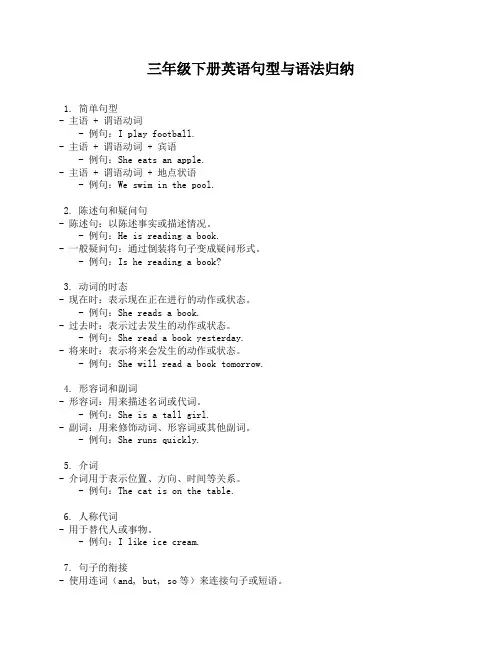
三年级下册英语句型与语法归纳1. 简单句型- 主语 + 谓语动词- 例句:I play football.- 主语 + 谓语动词 + 宾语- 例句:She eats an apple.- 主语 + 谓语动词 + 地点状语- 例句:We swim in the pool.2. 陈述句和疑问句- 陈述句:以陈述事实或描述情况。
- 例句:He is reading a book.- 一般疑问句:通过倒装将句子变成疑问形式。
- 例句:Is he reading a book?3. 动词的时态- 现在时:表示现在正在进行的动作或状态。
- 例句:She reads a book.- 过去时:表示过去发生的动作或状态。
- 例句:She read a book yesterday.- 将来时:表示将来会发生的动作或状态。
- 例句:She will read a book tomorrow.4. 形容词和副词- 形容词:用来描述名词或代词。
- 例句:She is a tall girl.- 副词:用来修饰动词、形容词或其他副词。
- 例句:She runs quickly.5. 介词- 介词用于表示位置、方向、时间等关系。
- 例句:The cat is on the table.6. 人称代词- 用于替代人或事物。
- 例句:I like ice cream.7. 句子的衔接- 使用连词(and, but, so等)来连接句子或短语。
- 例句:I like apples and bananas.8. 祈使句- 用于表达请求、命令等。
- 例句:Close the door, please.9. 疑问词- 用于提问,如who, what, where, when, why, how等。
- 例句:Where is the nearest supermarket?10. 句型转换- 可以通过改变句子结构或词序来改变句子的意思。
三年级英语语法大全
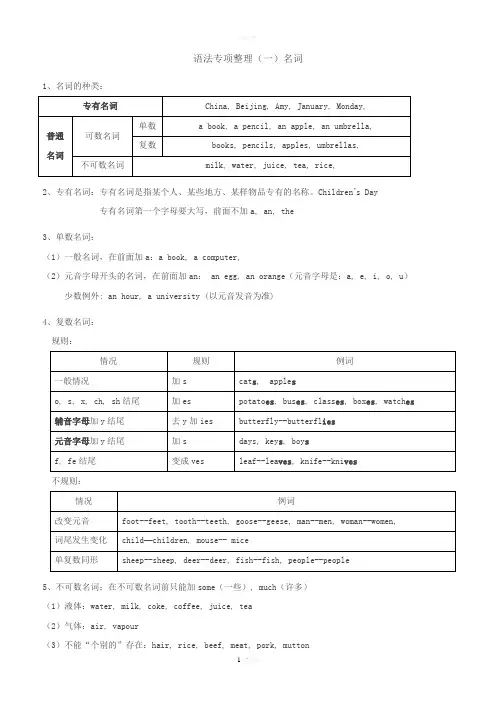
1、名词的种类:2、专有名词:专有名词是指某个人、某些地方、某样物品专有的名称。
Children’s Day专有名词第一个字母要大写,前面不加a, an, the3、单数名词:(1)一般名词,在前面加a:a book, a computer,(2)元音字母开头的名词,在前面加an: an egg, an orange(元音字母是:a, e, i, o, u)少数例外: an hour, a university (以元音发音为准)4、复数名词:规则:不规则:5、不可数名词:在不可数名词前只能加some(一些), much(许多)(1)液体:water, milk, coke, coffee, juice, tea(2)气体:air, vapour(3)不能“个别的”存在:hair, rice, beef, meat, pork, mutton12、物主代词3、指示代词:this, that, these, those如:This is my doll. That is Mary’s.Look at the those sheep. They are eating grass.语法专项整理(三)数词1、基数词:表示数目的多少2、序数词:表示顺序1、介词的分类2、at, on, in在表示时间时的区别:(1)at用于具体的时刻:at 10:05, at noon, at night,(2)on用于具体的一天(常与星期、节日、具体的某一天连用,也表示某天上午、下午或晚上):on Monday, on New Year’s Day, on June 1st, on my birthday, on Friday morning, on the weekend, (3)in用于某一段时间(常与上午、下午、晚上连用,常与月份、季节、年份连用):in the morning, in the afternoon, in the evening, in March, in spring, in 2007,语法专项整理(六)There be结构1、概念:There be结构又叫存在句,表示某地存在某物。
人教版三年级上册英语语法知识点
人教版三年级上册英语语法知识点一、一般现在时定义:一般现在时表示现在经常反复发生的动作、状态或习惯。
通常与“动词原形”或“动词第三人称单数形式”连用。
用法:表示现在的状态,如I am a student. 我是一个学生。
表示经常发生的动作,如We go to school every day. 我们每天上学。
表示习惯,如She usually sleeps late. 她通常睡得很晚。
构成:肯定句:主语+ 动词原形/ 动词第三人称单数形式+ 其他成分否定句:主语+ don't / doesn't + 动词原形+ 其他成分一般疑问句:Do / Does + 主语+ 动词原形+ 其他成分?注意:在一般现在时中,当主语是第三人称单数时,谓语动词需要使用第三人称单数形式。
二、名词和冠词定义:名词表示人、事物、地点或抽象概念的名称;冠词用于限定名词,表示名词所指的范围或程度。
用法:人称代词(主格和宾格)和物主代词(形容词性和名词性)的用法。
表示时间、地点、方位的介词的用法。
注意:冠词分为不定冠词(a / an)和定冠词(the)。
在句子中,不定冠词用于限定泛指的名词,而定冠词用于限定特指的名词。
三、数量表达法定义:数量表达法用于表示数量、长度、高度、重量等度量衡的概念。
用法:使用适当的量词短语来表示数量,如one apple, two bananas, three pears等。
注意量词短语的正确搭配。
注意:当需要表示长度、高度、重量等度量衡时,需要使用正确的单位,如meter、kilogram 等。
四、介词和连词定义:介词用于表示名词或代词与句子其他部分之间的关系;连词用于连接两个句子或从句。
用法:介词用于表示时间、地点、方位等概念,如in the morning, on Sunday等;连词用于连接两个句子或从句,如and、but、or等。
注意:介词和连词的用法有时会受到语境的影响,需要根据具体情况进行判断和选择。
三年级上册英语语法知识点总结
三年级上册英语语法知识点总结三年级上册英语语法知识点总结1. 一般现在时 (Present Simple Tense)- 表示经常性的事实或习惯;- 动词原形加s或es;- 否定句用do not或does not;- 疑问句用do或does开头。
2. 人称代词 (Personal Pronouns)- 主格:I, you, he, she, it, we, they;- 用于代替人或事物。
3. 形容词 (Adjectives)- 用来描述人、物或事物的特征;- 通常放在名词前。
4. 不可数名词 (Uncountable Nouns)- 用来表示无法具体计数的东西,如水、沙子等;- 与单数动词连用。
5. 可数名词 (Countable Nouns)- 可以用数字计数的名词,如猫、苹果等;- 单数用单数形式动词,复数用复数形式动词。
6. 介词 (Prepositions)- 用来表示方位、时间、原因等关系;- 如in, on, under等。
7. 欲望句型 (Want Sentences)- 主语加want,后面加动词原形;- 表达自己的愿望。
8. 一般过去时 (Simple Past Tense)- 表示过去发生的动作或事情;- 动词加ed或用过去式。
9. 比较级和最高级 (Comparative and Superlative)- 用来比较两个或多个人或物之间的程度或大小;- 比较级要加er或more,最高级要加est或most。
10. 所有格 (Possessive)- 表示所有关系的词;- 名词后加's ('s)。
以上是三年级上册英语的一些常见语法知识点总结。
三年级下册英语句型与语法归纳
三年级下册英语句型与语法归纳在三年级下册的英语学习中,学生将继续掌握更多的句型和语法知识。
这些知识将帮助他们构建正确的句子,表达自己的意思。
下面是对三年级下册英语句型与语法的详细介绍。
一、句型:1. 主语 + be动词 + 形容词这个句型用来描述人或物的状态或特征。
例如:- He is tall.(他高)- The flower is beautiful.(花很漂亮)2. 主语 + 动词 + 宾语这个句型用来表示主语做了某个动作。
例如:- She reads a book.(她读书)- We eat dinner.(我们吃晚饭)3. 主语 + 动词 + 地点副词这个句型用来表示主语在某个地方做某个动作。
例如:- He swims in the pool.(他在游泳池里游泳)- They play soccer on the field.(他们在 ** 上踢足球)4. 主语 + 动词 + 时间副词这个句型用来表示主语在某个时间做某个动作。
例如:- I brush my teeth in the morning.(我早上刷牙)- They watch TV in the evening.(他们晚上看电视)5. 主语 + 动词 + 助动词 + 不定式这个句型用来表示主语将要做某个动作。
例如:- She is going to study for the test.(她准备要为考试学习)- We are going to visit the zoo.(我们打算要去动物园)6. 主语 + can + 动词这个句型用来表示主语具有某种能力。
例如:- He can swim.(他会游泳)- They can play the piano.(他们会弹钢琴)二、语法:1. 一般现在时这是最基本的时态,用来表示经常或一直发生的事情。
句子中的动词要用原形。
例如:- She likes ice cream.(她喜欢冰淇淋)- We go to school every day.(我们每天去上学)2. 现在进行时这个时态用来表示现在正在发生的事情。
三年级第一学期语法及句型归类.doc
三年级第一学期语法及句型归类
一、语法:
1.a an the 的用法区别:
元音字母a e i o u开头的单词前用an; ( an apple )
辅音字母开头的单词前用 a ; ( a pen )
世界上独一无二的事物前用the (the sun ).
2.be 动词:is am are 的用法区别:
我(I)用am , 你(you)用are, is 用于它、它、它(it),
单数用is ,复数用are ,be 动词分为is am are.
3.改否定句的方法:
先找be动词is, am are, 在be 动词后面加not (或者用缩写形式)。
例如:This is a car. 改成:This is not a car .
或改成:This isn’t a car .
4、.改一般疑问句的方法:
先找be动词is, am are,,把be动词提前到句子开头,变换大小写,句末加?
例如:That is an apple .改成:Is that an apple ?
5、名词单数变复数的方法:
(1)直接+s : pen-pens ball-balls
(2)、以s, x, ch, sh结尾的,加es. bus-buses box-boxes
(3)、把oo改为ee.:tooth-teeth foot-feet
(4)、特殊变化:child-children
二、句型归类:
1.一般疑问句的回答:一般疑问句没有疑问词,回答时要答Yes\No .
2.特殊疑问句有疑问词,回答时不能用Yes或No。
3.日常对话:。
- 1、下载文档前请自行甄别文档内容的完整性,平台不提供额外的编辑、内容补充、找答案等附加服务。
- 2、"仅部分预览"的文档,不可在线预览部分如存在完整性等问题,可反馈申请退款(可完整预览的文档不适用该条件!)。
- 3、如文档侵犯您的权益,请联系客服反馈,我们会尽快为您处理(人工客服工作时间:9:00-18:30)。
三年级下册期末复习资料
一、句型复习:
一般疑问句:Is this/that/it a ...? 回答:Yes,it is. No,it isn’t.
Is he / she…? 回答:Yes, he /she is. No, he/she isn’t.
Are you …? 回答:Yes, I am. No, I am not.
Are these/they ...? 回答:Yes,they are. No,they aren’t.
Do you...? 回答:Yes, I do. No, I don’t.
Is there...? 回答:Yes,there is. No, there isn’t.
Are there...? 回答:Yes,there are. No, there aren’t.
特殊疑问句:Who’s he/she ? 回答:He’s/She’s…
Who are they? 回答:They are...
Where is..? 回答:It’s in/on...(介词短语)
Where are…? 回答:They are in/on...(介词短语)
Where are you from? 回答:I am from... / We are from...
Where is he / she/ it from? 回答: He /She / It is from …
Where are they from? 回答: They are from....
What’s in / on / near/ under / beside the …? 回答:There is
/are ...
How many...? 回答:There is one./There are two.(2个或2个以上的数字) What is it/this/that? (单数) 回答:It’s a …….
What are they/these/those? (复数)回答: They’re …
日常用语:Put...on/in(介词短语)... 回答: OK/All right.
Draw... 回答: OK/All right.
Thank you! 回答: You’re welcome.
Here’s ... 回答:Thank you!
二、名词单数变复数,一般都把s 加。
特殊变化有以下:
1.单数复数一个样, sheep--sheep fish- fish goldfish - goldfish
Chinese-Chinese Japanese -Japanese
2.遇到oo 变ee : foot-feet goose- geese tooth - teeth
3.有些变化就是大:mouse – mice child - children man-men woman-women
4 .以s, x, sh, ch 结尾,+es (bu s-buses, bo x-boxes, bru sh-brushes,
wat ch-watches)
5、以0 结尾(有生命的o)+es (tomat o-tomatoes)(番茄)
例外:kangaroo- kangaroos
6、以辅音字母+y结尾,改y为i+es ( la dy-ladies, ba by-babies stu dy-studies)
7.以f 或fe结尾,改f或fe为v+es (kni fe- knives shel f-shelves)
三、have与has 的区别:
have, has 都是“有”,
它们的用法有讲究, 表示“某人有某物”,have, has请记住。
he, she, it “有”用has, I, we , they , you 都用 have。
主人单数用 has , 主人复数用 have。
have 就是能力强,疑问(?)否定(don’t / do not)都用它。
四、have ,has 与there is , there are 的区别
表示某人或某动物有: has / have (I have a dog. The dog has a short tail.)
表示某地方有: there is / are (There is a book in the bag. )
五、Some与any 的区别:
some用于肯定句中,any用于否定句和疑问句中。
如:I have some books. I don’t have any books. Do you have any books ?
六.a 与an 的区别
一般来讲,元音字母(即a, e , i, o , u )开头的单词用an
如: an apple an ear an American girl an Australian stamp an old man
七. There be 句型(即 there is / there are )
意思:表示某地方有某人或某物
原则:就近原则(There be 句型中的be 动词用is 还是用are 由最靠近它的第一个名词是单数还是复数决定。
)
如: There is a book and some pens on the desk.
There are some pens and a book on the desk.
八.不可数名词: juice chalk tissue (不可数名词没有复数形式)
There is some chalk.
There is some juice.
There is some tissue.
九.’s所有格:表示:某人或某动物的
the girl’s name 那个女孩的名字
the teacher’s desk 讲台
the headmaster’s office 校长的办公室
the children’s toys 儿孩子们的玩具
the teachers’ room 教师办公室(当名词的复数形式是以“s”结尾时,直接加’)
十. be 动词 : is are am (表示“是”)
I 用am , you 用are , is 连着he,she ,it 。
单数名词用is ,复数名词全用are 。
如: I am …. You are… . We are… . They are…. . He is….. She is….. It is….
The girl is …. The boys are…. Ben is…. Janet and Ben are…
十一.代词。
